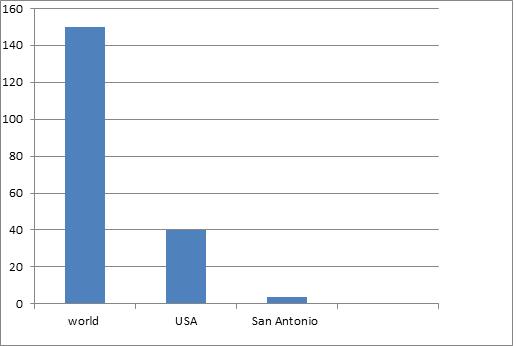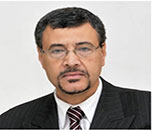Theme: Integrating the Milestones in Gynec Health Globally
Gynecology-2015
OMICS International is esteemed to invite you to join the 2nd International conference on Gynecology and Obstetrics which will be held from November 16-18, 2015 at San Antonio, USA which includes prompt keynote presentations, Oral talks, Poster presentations and Exhibitions.
Gynecology 2015 offer a cutting edge program of renowned international speakers,specialist concurrent sessions, short paper and poster presentations attracting over 450 experts in fertility,assisted conception, sexual health and reproductive biology and gynecology field.This conference has been carefully designed to meet the unique educational needs of Gynecologist. In addition to cutting-edge presentations and debates, this year agenda provides you an opportunity to participate in or organize a workshop.
Track 1. Midwifery : Midwifery is a broad topic and is professional in gynecology and No. of Research institutes working on the Midwifery approximately 20 or more then that as well as some university are also who gave training for to women to be midwifery and most of midwives are women, total number of university are approximately 60 working on midwifes and also funding are $10000- $20000 and 30% industry, Academia 40% and Others 30% are include at this topic. The midwife is the professional in obstetrics. The term is used in reference to both women and men, although most midwives are female. According to the definition of the International Confederation of Midwives, which has also been adopted by the World Health Organization and the International Federation of Gynecology and Obstetrics: A midwife is a person who, having been regularly admitted to a midwifery educational program that is duly recognized in the country in which it is located, has successfully completed the prescribed course of studies in midwifery and has acquired the requisite qualifications to be registered and/or legally licensed to practice midwifery. Midwifery in low income countries like Egypt, Pakistan, India, Uzbekistan, Ethiopia, Baluchistan and some of the region of south America and other countries.
Midwifery was reintroduced as a regulated profession in most of Canada's ten provinces in the 1990s. After several decades of intensive political lobbying by midwives and consumers, fully integrated, regulated and publicly funded midwifery is now part of the health system in the provinces of British Columbia, Alberta, Saskatchewan, Manitoba, Ontario, Quebec, and Nova Scotia, and in the Northwest Territories and Nunavut. Midwifery legislation has recently been proclaimed in New Brunswick where the government is in the process of integrating midwifery services there. Only Prince Edward Island, Yukon and Newfoundland and Labrador do not have legislation in place for the practice of midwifery.
Midwifery care is recognized as a responsible and accountable professional who works in partnership with women to give the necessary support, care, and advice during pregnancy, labor, and the postpartum period; to conduct births on the midwife's own responsibility; and to provide care for the infant. This care includes preventive measures, the promotion of normal birth, the detection of complications in mother and child, accessing of medical or other appropriate assistance, and the carrying out of emergency measures. A midwife who is credentialed appropriately is qualified to practice in any setting including in the home, the community, hospitals, clinics or health units.
Recent developments in midwifery research in all four countries (Germany, Austria, Switzerland and the Netherlands) different courses, in timing as well as content, characterized its development in the individual countries. Major factors contributing to this development during the last decades involved the history and character of midwifery, initiatives of individual midwifery researchers, alliances with other professions and the transition of midwifery programmers into higher education. Whereas midwifery research is currently established as a professional role in all countries, future challenges involve the creation of its own profile and identity, while building up its own academic workforce and strengthening the role of midwifery in multidisciplinary alliances.
The role of multi-ethnic community midwives include the initial appointments with pregnant women, managing clinics, postnatal care in the home, and attending home births. A community midwife would typically have a pager and be responsible for a particular area, contacted by ambulance control when needed. Sometimes they are paged to help out in the hospital when there are insufficient midwives available.
Related Conferences on Midwifery :
2nd Annual Congress & Medicare Expo on Primary Healthcare, September 15-17, 2016 USA; 5th International Conference on Family Nursing , June 13-15, 2016 USA; 6th Global Healthcare & Fitness Summit, August 22-24, 2016 USA; 8th Nursing and Healthcare Congress, October 3-5, 2016 Canada; 5th International Conference and Exhibition on Occupational Health & Safety , June 6-7, 2016 USA; 3rd International Primary Health Care Reform Conference, March 14-16, 2016 Australia; 4th Annual Worldwide Nursing Conference, July 18-19, 2016 Singapore; Primary Care and Public Health, 18-19 May, 2016 UK; 8th IMA Conference on Management of Health, March 21-23, 2016 UK; 4th Annual Primary Care Winter Conference, February 15-19, 2016 Hawaii.
Track 2. Maternal-Fetal Medicine : Maternal-fetal medicine is a broad topic and is professional in gynecology and No. of Research institutes working on the Maternal-fetal medicine approximately 33 or more then that as well as some university are also who gave training for to women to be Maternal-fetal medicine , total number of university are approximately 150 working on Maternal-fetal medicine and also funding are $30000- $50000 and 20% industry, Academia 30% and Others 50% are include at this topic.
Maternal-fetal medicine (MFM) is the branch of obstetrics that focuses on the medical and surgical management of high-risk pregnancies. Management includes monitoring and treatment including comprehensive ultrasound, chorionic villus sampling, genetic amniocentesis, and fetal surgery or treatment. Obstetricians who practice maternal-fetal medicine are also known as primatologists. This is a subspecialty to obstetrics and gynecology mainly used for patients with high-risk pregnancies. Obstetric medicine is a closely related specialty that emphasizes the care of medical problems in pregnancy.
Hypertrophic cardiomyopathy (HCM) is a primary disease of the myocardium (the muscle of the heart) in which a portion of the myocardium is hypertrophied (thickened) without any obvious cause, creating functional impairment of the cardiac muscle. It is a leading cause of sudden cardiac death in young athletes.The occurrence of hypertrophic cardiomyopathy is a significant cause of sudden unexpected cardiac death in any age group and as a cause of disabling cardiac symptoms. Younger people are likely to have a more severe form of hypertrophic cardiomyopathy.
Maternal fetal medicine practice & procedures requires practice in obstetric ultrasound, invasive prenatal diagnosis using amniocentesis and chorionic villus sampling, and the management of high-risk pregnancies. Some of them are further trained in the field of fetal diagnosis and prenatal therapy where they become competent in advanced procedures such as targeted fetal assessment using ultrasound and Doppler, fetal blood sampling and transfusion, ceroscopy, and open fetal surgery.
Fetal and maternal factors associated with neonatal adiposity as measured by air displacement plethysmography. There is evidence that the fetal and early postnatal environments play a role in determining the risk of lifetime obesity, diabetes and cardiovascular disease. Neonatal body composition, as a surrogate marker of the in-utero environment,can be reliably and accurately measured by air displacement plethysmography (ADP).
Signalling, status and inequities in maternal healthcare explain and address these differentials have focused predominantly on increasing awareness, geographic and financial accessibility. However, in a context where 70% of healthcare is private sector provided, it becomes pertinent to consider the value associated with this good. Maternal healthcare use across socioeconomic groups within a rural community, and the meanings and values attached to this behaviour, to provide new insight into the causes of persistent inequity.
Abortion is the ending of pregnancy by the removal or forcing out from the womb of a fetus or embryo before it is able to survive on its own. An abortion can occur spontaneously, in which case it is often called a miscarriage. It can also be purposely caused in which case it is known as an induced abortion. The term abortion most commonly refers to the induced abortion of a human pregnancy. The similar procedure after the fetus may be able to survive on its own is medically known as alate termination of pregnancy.
Maternal and neonatal complications have increased for deliveries that occur at early- vs late-term gestation. The reasons for the increase in the rate of elective early-term deliveries are unclear but likely involve both patient and physician factors. Various strategies have been used to increase awareness of the morbidities associated with the practice of elective early-term delivery and to reduce its frequency. Insurers and quality accrediting agencies are increasingly holding hospitals accountable for their rates of elective early-term deliveries, and this pressure will likely continue to lead to widespread change in the practice of obstetrics. The interventions to increase adherence to evidence-based medicine guidelines that are described within this review may also be applicable to other areas of medicine. Maternal nutritional status is one of the most important factors of fetal growth and development. Consequently, the currently increasing prevalence of underweight women worldwide has come in the focus of interest of perinatal medicine. The aim of the study was to assess the effect of low pre-pregnancy body mass index (BMI) on fetal growth.
Fetal blood testing is a technique used in obstetrics during labor to confirm whether fetal oxygenation is sufficient. The procedure can be performed by creating a shallow cut by a transvaginally inserted blood lancet, followed by applying a thin pipe to the site that samples blood by capillary action. Two constituents that are commonly tested by this method are pH and lactate, both being indicators of acid base homeostasis. A low pH and high level of lactate indicate that there is acidosis, which in turn is associated with hypoxia.
Related Conferences on Maternal-fetal Medicine:
2nd International Conference on Gynecology & Obstetrics November 16-18, 2015, USA ; 3rd International Conference on Endocrinology November 02-04, 2015, USA ;International Conference on Metabolic SyndromesOctober 20-22, 2016 UAE; International Conference on Targeting Diabetes and Novel Therapeutics September 14-16, 2015, USA;22nd World Congress on Controversies in Obstetrics, Gynecology & Infertility 2015 (COGI 2015) September 17-20, 2015, Hungary;7th Health Care and Fitness Summit September 26-28, 2016, UK ; 6th Global Healthcare & Fitness Summit August 22-24, 2016, USA ; Pregnancy Summit & Child Health August 29-31, 2016, Brazil; International Conference onReproductive Health August 29-31, 2016 USA; 4th International Conference on Nursing & Healthcare October 05-07, 2015, USA; 18th Annual NPWH Premier Women's Healthcare Conference October 14 - 17, 2015.
Track 3. Urogynecology : Uro gynecology is a broad topic and is professional in gynecology and No. of Research institutes working on the Uro gynecology approximately 30 or more then that as well as some university are also who gave training for to women to be Uro gynecology , total number of university are approximately 70 working on Uro gynecology and also funding are $10000- $30000 and 10% industry, Academia 30% and Others 60% are include at this topic it is a surgical sub-specialty of urology and gynecology. Urogynecology is also known as - The subspecialty of Female Pelvic Medicine and Reconstructive Surgery. Urogynecology involves the diagnosis and treatment of urinary incontinence and female pelvic floor disorders.Robotic-assisted surgery has evolved over the past two decades with constantly improving technology, assisting surgeons in multiple subspecialty disciplines.
Robotic-assisted surgeries are gaining popularity in urologic surgery due to the possibility of manipulation through the natural orifices.
Gynecological malignancies consist Endometrial, Ovarian, and Cervical Cancer and covers on the detection, diagnosis, prevention, and treatment of ovarian cancer. Specific areas of interest include clinical research and mechanistic approaches, drug sensitivity and resistance, gene and antisense therapy, pathology, markers, and prognostic indicators, chemoprevention strategies, multimodality therapy, and integration of various approaches. three common gynecologic malignancies encountered in the operating arena: endometrial, cervical, and vulvar cancer.
Endometrial cancer is the most common of the gynecologic malignancies. Approximately 2% to 3% of women in the United States will develop cancer of the endometrium at some point during their lives. With an estimated 37,000 new cases last year, it is the fourth most common malignancy among women. It predominantly affects older women, with 75% of cases occurring in the postmenopausal years. laparoscopic ureteral reimplantation is an effective minimally invasive treatment option for distal ureteral strictures. This minimally invasive technique allows for treatment of long strictures of the distal ureter, without the need for complex reconstructive maneuvers. ureteral reimplantation is a successful and well-tolerated procedure with a proven track record in the surgical management of vesicoureteric reflux, the laparoscopic approach offers another option which improves on the open procedure with better cosmesis and convalescence, while providing a durable and successful procedure compared to injection therapy.
Complications in endoscopic surgery is not known. However, knowledge of the possible complications and the reasons for these complications helps to adopt a careful approach when performing endoscopic procedures. The major areas of concerns during endoscopic procedures: anesthetic related complications, complications arising from insufflated gases, access related injuries, injuries and complications resulting from improper use of endoscopic instruments, bleeding complications, visceral injuries, port-site complications and thermal injuries. A section on injuries and complications that may also arise due to improper positioning of the patient on the operating table has also been included.
laparoendoscopic single-site (LESS) surgery can be used for salpingostomy or salpingectomy to treat tubal ectopic pregnancy. ESS could be used to treat benign and malignant adnexal disease, and for hysterectomy. For adnexal disease, LESS can be used to remove ovarian cysts, salpingo-oophorectomy, to remove endometriosis, and remove malignant masses. Single-port access subtotal hysterectomy is more commonly used now, with various advancements in place to overcome the limited free movement and technical difficulty. Robotic LESS has been used in gynecology for bilateral salpingo-oophorectomy and total hysterectomy. The shift from open surgery to operative laparoscopy brought on one of the greatest transformations in the history of surgery. Advancements in surgical instruments, optics, and ports have allowed the development of single port laparoscopy, or laparoendoscopic single-site surgery (LESS).
Ureteral Injury in Laparoscopic Gynecologic Surgery is indirectly or in other words of medical known as a laparoscopy to gynecologic surgery. It has allowed for both innovative advancements and new challenges in the field. As the complexity of laparoscopically approached gynecologic cases continues to increase, it is imperative for surgeons to be aware of the risk of ureteral injury. Although rare, ureteral complications with gynecologic surgery may be quite morbid; therefore, knowledge about their prevention, diagnosis, and management is of the utmost importance.
Ureteral injury occurs in 0.5% to 1.5% of traditional open gynecological surgery. The true incidence of ureteral injury in laparoscopic surgery is unknown at this time, although it is believed to be higher than that of traditional surgery. Ureteral injuries have the best prognosis when they are recognized and repaired intraoperatively. A delay in diagnosis can lead to progressive deterioration of renal function. As many as 25% of unrecognized ureteral injuries result in eventual loss of the affected kidney. Inferior imaging of the urologic patient by IVP leads to the acquisition of additional imaging studies to render a diagnosis. IVP has a limited clinical role, and thus, its use should be strictly limited to highly select cases.
Interstitial cystitis (IC) is a syndrome characterized by urinary urgency and frequency, usually with pelvic pain and nocturia, in the absence of bacterial infection or any other identifiable pathology. Overactive bladder (OAB) and interstitial cystitis (IC) have similar symptoms, including urinary urgency/frequency and nocturia, making them difficult to differentiate on the basis of clinical presentation alone. Both conditions may represent a clinical manifestation of a hypersensitive bladder and should be included in the differential diagnosis for patients who present with urgency/ frequency. It is especially important that IC be considered in patients with OAB that is refractory to treatment. The proposed diagnostic framework may be useful for differentiating IC from OAB and for facilitating appropriate treatment. The condition can be severely debilitating, interfering with employment, social relationships, and sexual activity. Interstitial cystitis may go undiagnosed for years, particularly in cases of mild or moderate disease. Both IC and OAB should be considered in the differential diagnosis of patients with symptoms of urgency and/or frequency. Vesicovaginal fistula (VVF) is a subtype of female urogenital fistula (UGF). It is often caused by childbirth. Vesicovaginal fistulae are typically repaired either transvaginally or laparoscopically, although patients who have had multiple transvaginal procedures sometimes attempt a final repair through a large abdominal incision, or laparotomy. Vaginal Agenesis is refered to or is a condition in which the vagina is abnormally closed or absent. The main causes of vagina is abnormally closed or absent are Complete vaginal hypoplasia or A vaginal obstruction. In women with vaginal agenesis progressive perineal dilation provides a minimally invasive method to create a functional vagina without the attendant risks or complications of traditional surgical options.
Related Conferences on Urogynecology :
International Conference on Cervical Cancer, September 22-23, 2016 Vienna, Austria. International Conference and Exhibition on Surgical Oncology, September 01-03, 2016 Sao Paulo, Brazil. 7th Global Summit on Cancer Therapy, October 05-07, 2015, Dubai,UAE. Cancer Diagnostics Conference & Expo, June 13-15,2016 Rome, Italy. 8th Euro Global Summit on Cancer Therapy , November 03-05, 2015, Valencia,Spain. ASCO/BGICS Joint Session at the Breast Gynecological International Cancer Conference, January 14- 15, 2016, Egypt.ASCO/RUSSCO Joint Session at the Russian Gynecological Cancer Conference, March 18- 19, 2016, Russia, , Tenth AACR-JCA Joint Conference on Breakthroughs in Cancer Research: From Biology to Therapeutics, February 16 - 20, 2016 Hawaii, USA. The International Federation of Gynecology and Obstetrics (FIGO), 4-9 October 2015, Vancouver, Canada.International Symposium on Advanced Ovarian Cancer: Optimal Therapy, 06 Mar 2016, Valencia, Spain.
Track 4. Gynecological Endocrinology : The Number of Research institutes working on the Gynecological Endocrinology : 25 approximately and Number of Universities working on this topic are approximately 80 and funding towards t h research are approximately given by University or research institute approximately $20000 - $30000 and 30% industry, Academia 20% and Others 50% are also include on this topic .
Gynecological Endocrinology refers to the treatment of disorders related to fertility, menstruation and menopause.Reproductive endocrinology Fetal-Placental neuroendocrine development refers to type of a subspecialty that focuses on the biological causes and interventional treatment of infertility and its development.
Pediatric and adolescent gynecology refers to a medical specialty that manages medical conditions affecting babies, children and young people.
Pediatric gynecology to the medical care about women before child birth and adolescent gynecology to same as but the different is adolescent refers to care about women after the birth as well as care about child.
Neuroendocrinology is the study of the interaction between the nervous system as well as same time about the endocrine system, including the biological features of the cells involved, and how they communicate. The neuroendocrine system is the mechanism by which the hypothalamus maintains homeostasis, regulating reproduction, metabolism, eating and drinking behavior, energy utilization, osmolality, and blood pressure. We can also define neuroendocrinology, like - branch of biological science devoted to the interactions between the two major integrative organ systems of animals-the endocrine and nervous systems.
Hormone replacement therapy (HRT) can be an effective treatment for the typical menopause-related symptoms. Other long-term health problems associated with the menopause: the risk of osteoporosis, cardiovascular disease and stroke all increase after the menopause. HRT may also have an influence on these health problems. For women with premature (age <40 years) or early (<45 years) menopause, current guidelines recommend HRT until the age of 51 years for the treatment of vasomotor symptoms and bone preservation.
Hormone replacement therapy (HRT) given as unopposed estrogen replacement therapy (ERT) gained widespread popularity in the United States in the 1960s and 1970s. Pregnancy refers to or also known as gravidity or gestation is the time during which one or more offspring develops inside a woman. Pregnancy is typically divided into three trimesters. The first trimester is from week one through twelve and includes conception. Conception is followed by the fertilized egg traveling down the fallopian tube and attaching to the inside of the uterus, where it begins to form the fetus and placenta. The first trimester carries the highest risk of miscarriage (natural death of embryo or fetus).The second trimester is from week 13 through 28. Around the middle of the second trimester, movement of the fetus may be felt. At 28 weeks, more than 90% of babies can survive outside of the uterus if provided high-quality medical care. The third trimester is from 29 weeks through 40 weeks.
Prenatal care improves pregnancy outcomes. Diabetes commonly referred to as Diabetes mellitus (DM). Diabetes is due to either the pancreas not producing enough insulin or the cells of the body not responding properly to the insulin produced. Health care providers now know that the key to a healthy pregnancy for a woman with diabetes is keeping blood glucose (sugar) in the target range—both before she is pregnant and during her pregnancy.
Related Conferences on Gynecological Endocrinology :
3rd International Conference on Gynaecology and Obstetrics October 17-19, 2016, UAE; Experts Meeting on Gynaecologic Oncology May 19-21 USA; 7th Health Care and Fitness Summit September 26-28, 2016, UK; International Conference and Exhibition on Surgical Oncology, September 01-03, 2016, Brazil; 4th Asia-Pacific Global Summit & Expo Healthcare, June 18-20, 2016 Australia; XXI FIGO World Congress of Gynecology & Obstetrics from October 4 - 9, 2015, Canada; Maternal Fetal Imaging Conference, Jan 29-31, 2016, USA; International Society for the Study of Women's Sexual Health (ISSWSH) Fall Course 2015, October 9-11,2015, USA; Mayo Clinic Gynecology and Gynecologic Surgery Update, October 1 - 3,2015, USA.
Track 5. Gynecological Oncolgy Nearly 80,000 women are diagnosed with gynecologic cancers in the United States, and half of those are uterine cancer diagnoses with a mortality of 8,000 women per year. Ovarian cancer found to be the 2nd most common gynecologic cancer with about 22,000 new cases per year, leading to 16,000 deaths yearly. Mortality for cervical cancer have decreased as Pap smears have become commonplace. Still, there are about 12,000 diagnoses every year with about 4,200 women die from this disease annually. Vulvar and vaginal cancer are relatively rare and when caught and treated early offers of reasonably good prognosis. 4,500 women are diagnosed with vulvar cancer each year, with about 950 women die from it. Vaginal cancer, meanwhile, account for about 2,600 diagnoses per year, and about 840 deaths. Every woman is at risk for developing a gynecologic cancer. It is estimated that there will be about 98,000 new cases diagnosed and approximately 30,000 deaths from gynecologic cancers in the United States during 2015 as per American Cancer Society. Out of which Uterine cancer has the large portion about 50% of cases with an estimated mortality rate of 18.5%. The Ovarian cancer has the highest estimated mortality rate at 66%.
Gynecologic oncology is a specialized field of medicine that focuses on cancers of the female reproductive system, including ovarian cancer, uterine cancer, vaginal cancer, cervical cancer, and vulvar cancer. In the United States, 82,000 women are diagnosed with gynecologic cancer annually. In 2013, an estimated 91,730 were diagnosed.
Radiation therapy is an essential component in Gynecology in the primary nonsurgical management and the adjuvant postoperative treatment of selected malignancies arising in the female reproductive tract. Gynecologic cancers were among the first malignancies treated with ionizing radiation, more than a century ago. Radiation therapy using as a treating cancers of the uterine corpus, uterine cervix, vulva, and vagina. Anaesthesia for gynaecological oncology surgery must anticipate prolonged procedures that have the potential for significant blood loss and postoperative pain. Preoperative assessment must also take into account systemic disease effects, particularly for ovarian cancer, as well as the consequences of prior chemotherapy and radiotherapy. Palliative care of the patient with gynecologic cancer requires attention to many diverse issues and the services of many different specialists. Patients with advanced gynecologic malignancies have a multitude of symptoms; pain, nausea, and vomiting, constipation, anorexia, diarrhea, dyspnea, as well as symptoms resulting from intestinal obstruction, hypercalcemia, ascites, and/or ureteral obstruction.
Palliative and supportive care services provide excellent care to patients near the end of life. During the last six months of life, the majority of gynecologic oncology patients receive anticancer therapy, While the majority of patients are referred forpalliative care, it appears that most patients spend less than 30 days on hospice. Exoneration refers to an ultraradical surgical procedure consisting of an en bloc resection of the female reproductive organs, lower urinary tract, and a portion of the rectosigmoid. Exenteration also refers to removal of the uterus, tubes, ovaries, parametrium, bladder, rectum or rectal segment, vagina, urethra, and a portion of the levator muscles. In an anterior exenteration, the rectum is spared, while in a posterior exenteration, the bladder and urethra are preserved. A perineal phase, resecting the anus, urethra, and portions of the vulva, may also be required.
Fibroid is a term used for two different types of tumors: Fibroids is the common term for uterine fibroids; leiomyoma or myoma originating in the uterus, A fibroid tumor is another name for a fibroma, a tumor of fibrous connective tissue.
Cervical is an adjective of or pertaining to the female cervix. Ovary is an ovum-producing reproductive organ, often found in pairs as part of the vertebrate female reproductive system. Ovaries in female individuals are analogous to testes in male individuals, in that they are both gonads and endocrine glands. Although ovaries occur in a wide variety of animals, both vertebrate and invertebrate, this article is primarily about ovaries in humans. The breast is the upper ventral region of the torso of a primate, in left and right sides, containing the mammary gland which a female can secrete milk, used to feed infants, Both men and women develop breasts from the same embryological tissues.
Related Conferences on Gynecology Oncology :
International Conference on Pancreatic and Colorectal Cancer, March 29-30, 2016, Alanta,USA. 4th International Conference on Blood Malignancies and Treatment, April 18-20, 2016, Dubai, UAE. 2nd International Conference on Prostate Cancer and Treatment, May 05-07, 2016,Chicago, USA. 2nd International Conference on Antimicrobial Agents and Chemotherapy, June 06-07,2016 Dallas, USA. Cancer DiagnosticsConference & Expo, June 13-15,2016 Rome, Italy.12th Focus on Gynecologic Cancers Conference, October 9, 2015, Philadelphia, PA. SGO Annual Meeting on Women’s Cancer, March 19-22, 2016, San Diego, CA.NCRICancer Conference,01-04 November,2015,UK. IARC 50th Anniversary Conference, 7–10 June 2016, Lyon, France, NRG Oncology january 2016 Meeting resources, January 21-24, 2016 in Atlanta, GA.
Track 7. Reproductive Medicine : Reproductive Medicine consist in Gynecology , the number of Research institutes working on the Reproductive Medicine: 120 approximately and number of Universities : 20-30 consisting the department of Medicine and funding towards the research on this topic approximately goes $90000 - $110000 , Target audience as well as industry as well as academia consist : 50% industry, Academia 20% and Others 30%.
Reproductive medicine is a branch of medicine that deals with prevention, diagnosis and management of reproductive problems; goals include improving or maintaining reproductive health and allowing people to have children at a time of their choosing. It is founded on knowledge of reproductive anatomy, physiology, and endocrinology, and incorporates relevant aspects of molecular biology, biochemistry and pathology. Regenerative medicine deals with the process of replacing, engineering or regenerating human cells, tissues or organs to restore or establish normal function.
A biomarker can be used for early diagnosis of a disease, identification of individuals for disease prevention, as a potential drug target, or as a potential marker for a drug response. A biomarker in reproduction could be used to improve assessment of exposure, identify subgroups susceptible to treatment, predict outcome, and/or differentiate subgroups with potentially different etiologies of disease.
Reproductive cloning involves creating an animal that is genetically identical to a donor animal through somatic cell nuclear transfer. the newly created embryo is placed back into the uterine environment where it can implant and develop refers to Reproductive cloning.
The role of hysteroscopy in patients undergoing IVF seems to be vital for patients in whom an IVF is being contemplated, for treatment of infertility. Diagnostic hysteroscopy should be performed before ART in all patients, including women with normal TVS and/or HSG findings, because a significant percentage of them have undiagnosed uterine disease that may impair the success of fertility treatment.
Related Conferences on Reproduction Medicine :
3rd International Conference on Gynecology & Obstetrics October 17-19, 2016, UAE; Polycystic Ovarian Syndrome Conference November 16-18, 2015, USA; Pregnancy Summit & Child Health August 29-31, 2016, Brazil; 2nd Global Summit on Hormones and Steroids June 23-25, 2016, USA; 3rd World congress on Women's Health and Breast Cancer; 18th Annual NPWH Premier Women's Healthcare Conference Oct 14-17, 2015, USA; Women's Health Conference, June 9-11, 2016, CA; Women's Health and OB/GYN Nursing, November 11 - 14, 2015, USA; High Risk Obstetric Nursing, November 11 - 14, 2015, USA; Contraceptive Technology, Nov 4-6, 2015, USA. MENA Women’s Health Congress, Nov 5-7, 2015, UAE.
Track 8. Prenatal Diagnosis : Prenatal Diagnosis consist in Gynecology , the number of Research institutes working on the Prenatal Diagnosis: 20-30 approximately and number of Universities : 80 consisting the department of Gynecology and funding towards the research on this topic approximately goes $10000 - $20000 , Target audience as well as industry as well as academia consist : 40% industry, Academia 20% and Others 40%. It is testing for diseases or conditions in a fetus or embryo before it is born. Diagnostic prenatal testing can be performed by invasive or non-invasive methods. The aim is to detect birth defects such as neural tube defects, Down syndrome, chromosome abnormalities, genetic disorders and other conditions, such as spina bifida, cleft palate, Tay Sachs disease, sickle cell anemia, thalassemia, cystic fibrosis, Muscular dystrophy, and fragile X syndrome.
Non-invasive techniques include examinations of the woman's womb through ultrasonography and maternal serum screens.
Related Conferences on Prenatal Diagnosis:
10th Global Annual Oncologists Meeting, July 11-13, 2016 Cologne, Germany. International Conference and Exhibition on Surgical Oncology, September 01-03, 2016 Sao Paulo, Brazil. International Conference on Cervical Cancer, September 22-23,2016 Vienna, Austria. 7th International Conference on Biomarkers & Clinical Research, November 28-30,2016 Baltimore, USA. Global Summit on Melanoma and Carcinoma, July 14-15, 2016, Brisbane, Australia. Markers in Cancer Diagnostic Development Tutorial, December 1-2, 2015 Brussels, Belgium. Cancer Vaccines: Targeting Cancer Genes for Immunotherapy, March 6—10, 2016, Canada. 2nd Annual Oncology Asia, Sep 14- 17 2015, Tokyo, Japan.Cancer-2016 International Cancer Study & Therapy Conference, April 4-6, 2016 Baltimore,USA. 8th General Assembly and International Conference of Asian Pacific Organization for Cancer Prevention (APOCP8),April 13-16,2016,Australia.
Track 9: Family Planning
The most important step in the regulation of world population includes Contraception and Family planning measures. The world is seeing a huge leap in the development of recent contraceptive technologies and assisted reproductive technologies like achieve pregnancy in procedures like artificial insemination, in vitro fertilization and surrogacy to combat issues like infertility and its evaluation. High-risk patients include patients with Sexually transmitted diseases, diseases like hypertension, diabetes and other complications. Evolving trends in contraception and technologies will play a major role in regulating a number of Reproductive Health indicators.
Family Planning consist in Gynecology, the number of Research institutes working on the Family Planning: 10-20 approximately and number of Universities : 40- 50 consisting the department of Gynecology and funding towards the research on this topic approximately goes $20000 - $40000 , Target audience as well as industry as well as academia consist : 10% industry, Academia 50% and Others 40%. Family planning is the planning of when to have children, and the use of birth control and other techniques to implement such plans. Advance methods of family planning include birth control, assisted reproductive technology and family planning programs. Good-quality post-MRFP increases contraceptive use, at least in the short term. Birth control is also known as contraception.
Related Conferences on Family Planning
5th International Conference on Family Nursing June 13-15, 2016 USA; International Conference and Exhibition on Surgical Oncology, September 01-03, 2016, Brazil; 7th Global Summit on Cancer Therapy, October 05-07, 2015, UAE; Cancer Diagnostics Conference & Expo, June 13-15,2016 Italy; 8th Euro Global Summit on Cancer Therapy, November 03-05, 2015, Valencia, Spain; ASCO/BGICS Joint Session at the Breast Gynecological International Cancer Conference, January 14- 15, 2016, Egypt; ASCO/RUSSCO Joint Session at the Russian Gynecological Cancer Conference, March 18- 19, 2016, Russia; Tenth AACR-JCA Joint Conference on Breakthroughs in Cancer Research: From Biology to Therapeutics, February 16 - 20, 2016 USA. The International Federation of Gynecology and Obstetrics (FIGO), 4-9 October 2015, Canada; International Symposium on Advanced Ovarian Cancer: Optimal Therapy, 06 Mar 2016, Valencia, Spain.
Trcak 10. Menopause : consist in Gynecology , the number of Research institutes working on the Family Planning: 40-50 approximately and number of Universities : 2 50 consisting the department of Gynecology and funding towards the research on this topic approximately goes $30000 - $50000 , Target audience as well as industry as well as academia consist : 20% industry, Academia 40% and Others 40%.
Menopause, also known as the climacteric, is the time in most women's lives when menstrual periods stop permanently, and she is no longer able to have children.
Pelvic floor dysfunction refers to a wide range of issues that occur when muscles of the pelvic floor are weak, tight, or there is an impairment of the sacroiliac joint, lower back, coccyx, or hip joints. Tissues surrounding the pelvic organs may have increased or decreased sensitivity or irritation resulting in pelvic pain. Many times, the underlying cause of pelvic pain is difficult to determine. Age at menopause is 51 but most women reach menopause between the ages of 45 and 55.
Premature menopause means the woman’s ovaries have spontaneously stopped working before she has reached the age of 40 years. Women can be affected in their teens or early 20s: About one in 1,000 women may reach menopause before the age of 30.
Related Conferences on Menopause :
NAMS 26th Annual Meeting September 30-October 3, 2015,Las Vegas, Nevada; 19th Australasian Menopause Society Congress September 25-27, 2015, Canberra, Australia; 18th International Conference on Menopause MAY 23-25, 2016,UK; 19th International Conference on Menopause MAY 21-23, 2017,Berlin, Germany; 3rd International Conference on Gynaecology and Obstetrics October 17-19, 2016, UAE; International Conference on Cardiac Nursing May 5-7, USA; 7th Health Care and Fitness Summit September 26-28, 2016, UK; 4th Asia-Pacific Global Summit & Expo Healthcare, June 18-20, 2016 Australia.
Track11. Infertility: Infertility may describe a woman who is unable to conceive as well as being unable to carry a pregnancy to full term.
Infertility is the inability of a person, animal or plant to reproduce by natural means. It is usually not the natural state of a healthy adult organism, except notably among certain eusocial species (mostly haplodiploid insects). The use of infertility services is not random. Understanding the sociodemographic factors correlated with use may assist new couples with family planning. Roughly 50% of the women evaluated for infertility progressed to treatment, and only a small proportion were treated with more advanced assisted reproductive technologies such as in vitro fertilization.
Obesity on reproductive health will concentrate on two key areas: infertility and heavy menstrual bleeding. Medical and surgical management of heavy menstrual bleeding is discussed including the many varied issues involved in hysterectomy of the obese woman. Women who are fertile experience a natural period of fertility before and during ovulation, and they are naturally infertile during the rest of the menstrual cycle.
Gynecology is the medical practice dealing with the health of the female reproductive systems and the breasts. GynecologyCancer and pre-cancerous diseases of the reproductive organs including ovaries, fallopian tubes, uterus, cervix, vagina and vulva. A gynaecologist is a doctor who treats medical conditions and diseases that affect women and their reproductive organs. Gynaecologists are also trained in obstetrics - the care of women during pregnancy and childbirth, which overlaps with gynecology. Obstetrics and gynaecology is the medical speciality dealing with fields of obstetrics and gynaecology through only one postgraduate training programme.
This combined training prepares the practicing OB/GYN to be adept at the care of female reproductive organs’ health and at the management of obstetric complications, even though surgery. Gynecologic oncology is a subspecialty of gynaecology, dealing with gynaecology-related cancer. Obstetric -Ultrasonography is the use of medical ultrasonography in pregnancy, in which sound waves are used to create real-time visual images of the developing embryo or foetus in its mother's (womb). The procedure is a standard part of prenatal care in many countries, as it can provide a variety of information about the health of the mother, the timing and progress of the pregnancy, and the health and development of the embryo.
Paediatric gynecology is also deals with the Obstetrics gynecology Gynaecologic Laparoscopy is one of the most common surgical procedures performed in the United States today. Approximately half of the 700,000 bilateral tubal sterilizations performed annually in the United States are performed laparoscopically. In addition to diagnostic laparoscopy, operative endoscopy is used to perform common procedures, including removal of ectopic pregnancies, treatment of endometriosis, and lysis of pelvic adhesions. Almost one third of the 600,000 hysterectomies performed annually in the United States are now performed with the aid of a laparoscope. Although the ideal role of laparoscopy in gynecologic surgerycontinues to be defined, it has become a standard approach for a large number of gynecologic procedures.
During pregnancy care must be taken to while consuming the gynec medicine. There are different pregnancy conferences are going to be taking place whole over the world like gynecology conferences, obstetrics and gynaecology conferences,gynecology congress. And there are different gynaecology associations like The American congress of Obstetrics and gynaecologists’, the society of Obstetrics and gynaecologists of Canada.
Related Conferences on Infertility :
3rd International Conference on Gynecology & Obstetrics October 17-19, 2016, UAE; Polycystic Ovarian Syndrome Conference November 16-18, 2015, USA; Pregnancy Summit & Child Health August 29-31, 2016, Brazil; 2nd Global Summit on Hormones and Steroids June 23-25, 2016, USA; 3rd World congress on Women's Health and Breast Cancer; 18th Annual NPWH Premier Women's Healthcare Conference Oct 14-17, 2015, USA; Women's Health Conference, June 9-11, 2016, CA; Women's Health and OB/GYN Nursing, November 11 - 14, 2015, USA; High Risk Obstetric Nursing, November 11 - 14, 2015, USA; Contraceptive Technology, Nov 4-6, 2015, USA. MENA Women’s Health Congress, Nov 5-7, 2015, UAE.
Track 12: Health-Related Behaviours In Women
Behavioral Health is a branch of interdisciplinary health which focuses on the reciprocal relationship between the holistic view of human behavior and the well-being of the body as a whole entity. Behavioral Health is issues that can have a different outcome by changing behavior. For example, giving up smoking can lessen the health problems or illnesses associated with cigarettes. Many health conditions are caused by risk behaviors, such as problem drinking, substance use, smoking, reckless driving, overeating, or unprotected sexual intercourse. Fortunately, human beings have, in principle, control over their conduct. Health-compromising behaviors can be eliminated by self-regulatory efforts, and health-enhancing behaviors can be adopted instead, such as physical exercise, weight control, preventive nutrition, dental hygiene, condom use, or accident prevention.
The term "healthy" is also widely used in the context of many types of non-living organisms and their impacts for the benefit of humans, such as in the sense of Health Care System and Law, Health Financing and Health Innovation, Policy and Evaluation. In addition to health care interventions and a person's surroundings, a number of other factors are known to influence the health status of individuals, including their background, lifestyle, and economic, social conditions, and spirituality; these are referred to as "determinants of health." Studies have shown that high levels of stress can affect human health. Health care (or healthcare) is the diagnosis, treatment, and prevention of disease, illness, injury, and other physical and mental impairments in human beings. Health care is delivered by practitioners in allied health, dentistry, midwifery (obstetrics), medicine, nursing, optometry, pharmacy, psychology and other health professions. It refers to the work done in providing primary care, secondary care, and tertiary care, as well as in Medicinal Healthcare, public health and Pediatric Healthcare.
Related Conferences on Health-Related Behaviours In Women
3rd International Conference on Gynecology & Obstetrics October 17-19, 2016, UAE; Polycystic Ovarian Syndrome Conference November 16-18, 2015, USA; Pregnancy Summit & Child Health August 29-31, 2016, Brazil; 2nd Global Summit on Hormones and Steroids, June 23-25, 2016, USA; 3rd World congress on Women's Health and Breast Cancer; 18th Annual NPWH Premier Women's Healthcare Conference Oct 14-17, 2015, USA; Women's Health Conference, June 9-11, 2016, CA; Women's Health and OB/GYN Nursing, November 11 - 14, 2015, USA; High Risk Obstetric Nursing, November 11 - 14, 2015, USA; Contraceptive Technology, Nov 4-6, 2015, USA.
OMICS International is esteemed to invite you to join the 2nd International conference on Gynecology and Obstetrics which will be held from November 16-18, 2015 at San Antonio, USA which includes prompt keynote presentations, Oral talks, Poster presentations and Exhibitions.
OMICS International Organises 1000+ Conferences every Year across USA, Europe & Asia with support from 1000 more scientific societies and Publishes 700+ Open access journals which contains over 50000 eminent personalities, reputed scientists as editorial board members.
Summary: Gynecology 2015 offer a cutting edge program of renowned international speakers,specialist concurrent sessions, short paper and poster presentations attracting over 450 experts in fertility,assisted conception, sexual health and reproductive biology and gynecology field.This conference has been carefully designed to meet the unique educational needs of Gynecologist. In addition to cutting-edge presentations and debates, this year agenda provides you an opportunity to participate in or organize a workshop.
Gynecology-2015 has been designed in an interdisciplinary manner with a multitude of tracks to choose from every segment and provides you with a unique opportunity to meet up with peers from both industry and academia and establish a scientific network between them. We cordially invite all concerned people to come join us at our event and make it successful by your participation.
A comprehensive range of topics will be discussed in the event including maternal fetal medicine, gynecology oncology, Sexual medicine, Substance Use & abuse, ultrasound diagnosis, Menstruation, leukoaraiosis, Endometriosis, Body Mass Index,genitourinary medicine, and Gynecologic Cancers. At OMICS, It is our ideology to bring maximum exposure to our attendees, so we make sure the event is a blend which covers professionals such as gynecologists, obstetricians, veteran researchers,women healthcare professionals from academia &industry making the conference a perfect platform.
Theme: Integrating the Milestones in Gynec Health Globally
Why to attend???
With members from around the world focused on learning about Women’s Health and its advances; this is your best opportunity to reach the largest assemblage of participants from the Women’s Health community. Conduct presentations, distribute information, meet with current and potential scientists, make a splash with new discoveries in the breast cancer treatment and diagnosis, and receive name recognition at this 3-day event. World-renowned speakers, the most recent techniques, developments, and the newest updates in women’s health, breast cancer, gynaecological issues, pregnancy, Woman Psychology, women disorders are hallmarks of this conference.
Target Audience:
Women’s Healthcare Students, Scientists and professors
Breast Cancer surgeons, pathologists
Women’s health Care Researchers
Healthcare Faculty
Medical Colleges
Healthcare Associations and Societies
Business Entrepreneurs
Training Institutes
Software developing companies
Manufacturing Medical Devices Companies
Data Management Companies
About the Conference:
Gynecology -2015 welcomes attendees, presenters, and exhibitors from all over the world to San Antonio, USA. We are delighted to invite you all to attend and register for the “International Conference on Gynecology and Obstetrics (Gynecology-2015)” which is going to be held during November 16-18, 2015 in San Antonio, USA.
Gynecology-2015 has been designed in an interdisciplinary manner with a multitude of tracks to choose from every segment and provides you with a unique opportunity to meet up with peers from both industry and academia and establish a scientific network between them. We cordially invite all concerned people to come join us at our event and make it successful by your participation.
A comprehensive range of topics will be discussed in the event including maternal fetal medicine, gynecology oncology, Sexual medicine, Substance Use & abuse, ultrasound diagnosis, Menstruation, leukoaraiosis, Body Mass Index, genitourinary medicine, and Gynecologic Cancers. At OMICS, It is our ideology to bring maximum exposure to our attendees, so we make sure the event is a blend which covers professionals such as gynecologists, obstetricians, veteran researchers, women healthcare professionals from academia &industry making the Gynecology-2015 conference a perfect platform.
For more details please visit- http://gynecology.conferenceseries.com/
Importance & Scope:
Obstetricians and gynecologists face a wide variety of challenges: managing the care of patients of all ages from puberty through menopause and beyond; treating both acute and chronic health conditions; and of course, managing risk through the pregnancy and childbirth process. The United States has a higher ratio of maternal deaths than at least 40 other countries, even though it spends more money per capita for maternity care than any other. The lack of a comprehensive, confidential system of ascertainment of maternal death designed to record and analyze every maternal death continues to subject U.S. women to unnecessary risk of preventable mortality. Maternal deaths must be reviewed to make motherhood safer.
The status of maternal deaths in the United States was part of a larger report on the global, regional, and national levels and causes of maternal mortality from 1990-2013. The findings suggest that only 16 countries will achieve a target of a 75% reduction in the maternal mortality ratio (or number of maternal deaths per 100,000 live births) by 2015.
The Omics Gynecology group has organized very successful conference on Gynecologic and Obstetrics in 2014 in Chicago, USA. and we recently approved a plan for accreditation in gynecological oncology ,reproductive medicine, infertility, pelvic floor disorder, ultrasound diagnosis, Menstruation, leukoaraiosis, Body Mass Index, genitourinary medicine, and Gynecologic Cancers based on the principles of Gynecology-2015 which includes more levels, respectively. The mission of the Gynecology-2015 is to promote gynecology and obstetrics research and development in USA from both industry and academia and establish a scientific network between them.
Why San Antonio
San Antonio is the third largest city in the state of Texas. It is the 7th largest city in the United States of America with a population of 1.33 million. The city was named after San Antonio de Padua, whose feast day is on June 13, when a Spanish expedition stopped in the area in 1691.
Famous for Spanish missions, the Alamo, the River Walk, the Tower of the Americas, the Alamo Bowl, Marriage Island and host to SeaWorld and Six Flags Fiesta Texas theme parks, the city is visited by approximately 26 million tourists per year according to the San Antonio Convention and Visitors Bureau. The city is home to the four-time NBA champion San Antonio Spurs and the annual San Antonio Stock Show & Rodeo, one of the largest in the country. San Antonio has a strong military presence. It is home to Fort Sam Houston, Lack Land Air Force Base, Randolph Air Force Base, and Brooks City-Base, with Camp Bullis and Camp Stanley outside the city. Kelly Air Force Base was operated out of San Antonio until 2001, when the airfield was transferred over to Lakeland AFB and the remaining portions of the base became Port San Antonio, an industrial/business park. San Antonio is home to five Fortune 500 companies and the South Texas Medical Center, the only medical research and care provider in the South Texas region
The jewel of the city is the River Walk, which meanders through the downtown area. The Alamo, located nearby, is Texas' top tourist attraction, while the River Walk is the second most visited attraction. Sea World, located 16 miles (26 km) west of downtown, is the 3rd attraction. San Antonio is home to the first museum of modern art in Texas, the McNay Art Museum. Other places of interest include the San Antonio Zoo, the Japanese Tea Garden, Brackenridge Park, the missions of the San Antonio Missions National Historical Park, San Antonio Museum of Art, San Antonio Botanical Garden and the Witte Museum..
San Antonio serves as the seat of Bexar County. The city has characteristics of other western urban centers in which there are sparsely populated areas and a low density rate outside of the city limits. The city is the anchor municipality of the San Antonio-New Braunfels metropolitan area; the other principal city is its largest suburb, New Braunfels. Commonly referred to as Greater San Antonio, the metropolitan area has a population of just under 2.2 million based on the 2011 U.S. Census estimate, making it the 24th largest metropolitan area in the United States and 3rd largest in the state of Texas.
Conference Highlights:
1: Midwifery
2: Maternal-Fetal Medicine
3: Urogynecology
4: Gynecological Endocrinology
5: Gynecological Oncology
6: Genitourinary Medicine
7: Sexual Medicine Novel approaches in genitourinary malignancies
8: Reproductive Medicine
9: Prenatal Diagnosis
10: Family Planning
11: Epidemiology in Obstetrics and Gynecology
12: Menopause
13: Operative Gynecology
14: Infertility
16: Maternal Suppliments
WHY TO ATTEND :
As the leading event in its niche field of ultrasound in obstetrics and gynecology, we were delighted to welcome international experts from all corners of the world to present cutting edge scientific breakthroughs, offer clinical guidance and participate in lively discussions on sub-specialist areas.
Unique opportunity to discuss case studies and meet some of the most influential professionals in ultrasound for obstetrics and gynecology . The program is presented through a variety of sessions including seminal plenary lectures and didactic workshops where international experts are invited to deliver lively discussion sessions on sub-speciality topics. Cutting-edge research updates comprise more than 50% of the program and are delivered through the oral communication, short oral and poster sessions.
A Unique Opportunity for Advertisers and Sponsors at this International event:
http://gynecology.conferenceseries.com/sponsors.php
Major Gynecology and Obstetrics Associations around the Globe
Association Gynecologists Obstetricians Tanzania AGOTA
Association Gynecologists Obstetricians Macedonia
Association Gynecologists Obstetricians Serbia, Montenegro Republic Srpska UGOSCGRS
Association Obstetricians Gynecologists Malawi AOGM
Association Obstetricians Gynecologists Uganda
American Association of Pro Life Obstetricians and Gynecologists
American College of Obstetricians and Gynecologists (ACOG)
Major Gynecology and Obstetrics Associations in USA
- American Association of Gynecologic Laparoscopists
- American Congress of Obstetricians and Gynecologists
- American Osteopathic Board of Obstetrics and Gynecology
- Southeast OB-GYN Associates, P.A.
- Lone Star OB/GYN Associates
- TEXAS ASSOCIATION OF OBSTETRICIANS AND GYNECOLOGISTS
- American Gynecological & Obstetrical Society
Statistical Analysis of Associations

Figure 1: statical analysis of associations related to obstetrics and gynecology
Target Audience:
DEAN, Doctors, Research associates, Professors, assistant professors, associate professors ,head of the departments, CEO of companies , related societies members, related association members and Students from Academia in the study gynecology and obstetrics filed.
Target Audience:
Industry 30%
Academia 40%
Others 30%

Figure 2 : Target Audience
Top Universities in USA
Harvard University
University of California, San Francisco
University of Pennsylvania
Johns Hopkins University
University of Pittsburgh

Figure 3: Top Universities in USA
Companies Associated with Obstetrics and Gynecology

Glance at revenue of Ob Gyn’s:
An Obstetrician / Gynecologist (OB/GYN) earns an average salary of $195,693 per year in USA. In 2011, obstetricians and gynecologists earned a mean income of $220,000, somewhat less than in the previous year. About 20% of ob/gyns earned $350,000 or more, slightly more than in last year's survey. Some 19% earned $100,000 or less, up from about 12% the previous year. Solo practitioners earned 93% of income from clinical practice compared to 89% for group practice ob-gyns. Those in group practice derived significantly greater percentages of income from teaching/research and other professional activities.
Statistics of, Researchers and Academicians working on Obstetrics and Gynecology:

REFERENCES:
A. http://www.figo.org/our-members
B. http://everydaylife.globalpost.com/5-top-colleges-ob-gyn-32179.html
C. http://www.merritthawkins.com/pdf/2010_revenuesurvey.pdf

Dear Colleagues,
It gives me a great pleasure as a member of the organizing committee and a keynote speaker at the 2nd International conference on Gynaecology and Obstetrics, on November 16-18, 2015 at San Antonio, USA. The theme for the conference this year is “Integrating the Milestones in Gynecological Health Globally" promises an outstanding scientific program featuring many well-known and thought provoking speakers.
Although the science and art of Gynecology has evolved over past decades and many technologies and medical advances have elevated the level of care in women’s health, we still witness disparities and inequities globally especially when it comes to maternal health and the social wellness of women in developing and third world countries.
The shift in medicine and healthcare from management of disease towards promoting wellness is a keystone in addressing the upstream caused of disease and ensuring that all women have equal opportunities to a healthy pregnancy and outcome. Therefore it is very appropriate to bring together the experts in the field from all over the globe as we share experiences and knowledge and work together on ensuring a just reproductive health to all women.
I hope that you will join us in San Antonio and share your experience with us.
Regards
Mouhanad Hammami, MD
County Health Officer &
Chief of Health Operations
Health and Human Services
Wayne County, Michigan
Conference Highlights
- Midwifery
- Maternal-Fetal Medicine
- Urogynecology
- Gynecological Endocrinology
- Gynecological Oncology
- Genitourinary Medicine
- Sexual Medicine Novel approaches in genitourinary malignancies
- Reproductive Medicine
- Prenatal Diagnosis
- Family Planning
- Epidemiology in Obstetrics and Gynecology
- Menopause
- Operative Gynecology
- Infertility
- Health-Related Behaviours In Women
- Maternal Suppliments
To share your views and research, please click here to register for the Conference.
To Collaborate Scientific Professionals around the World
| Conference Date | November 16-18, 2015 | ||
| Sponsors & Exhibitors |
|
||
| Speaker Opportunity Closed | Day 1 | Day 2 | Day 3 |
| Poster Opportunity Closed | Click Here to View | ||
Useful Links
Special Issues
All accepted abstracts will be published in respective Our International Journals.
Abstracts will be provided with Digital Object Identifier by
























